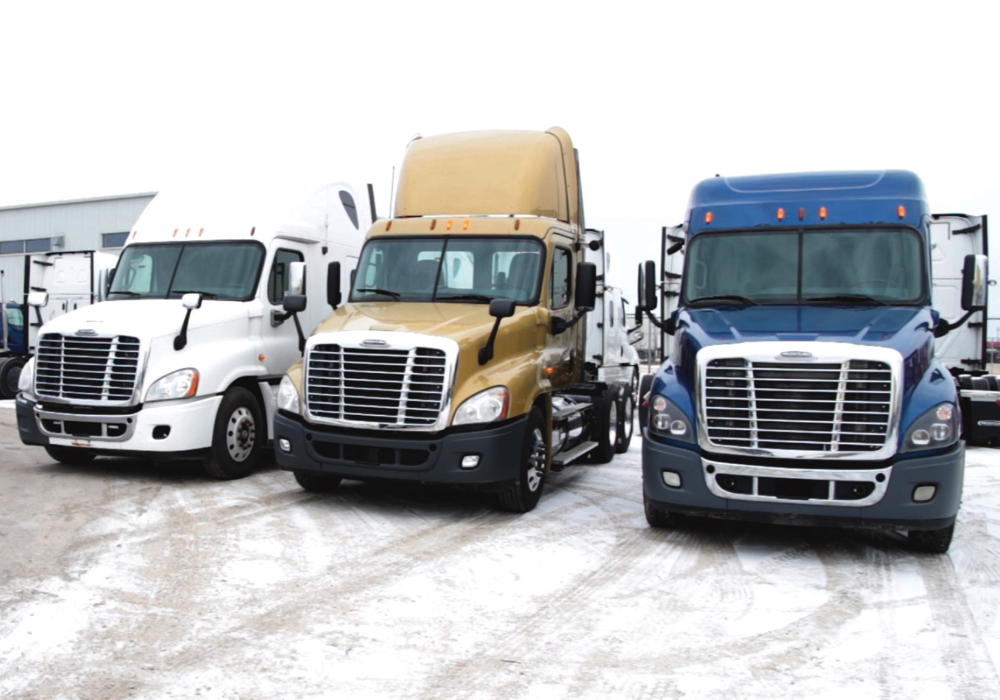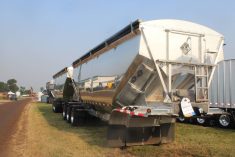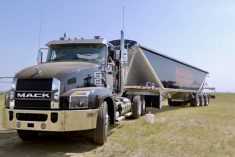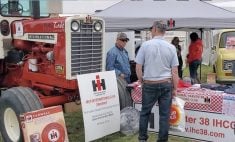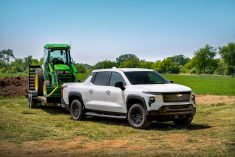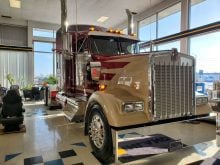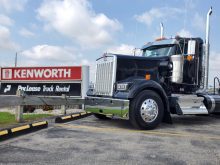Heading to a dealership or auction sale and bringing home a new-to-you machine is one of those experiences that just naturally goes with farming. Every producer will have done that many times over the course of his or her career. But shopping for heavy trucks compared to farm machines can be a little different experience. Trucks are subject to a host of strict regulations that off-road machines aren’t. And the cost of ensuring a heavy truck conforms to those regulations so it can be licenced — and, therefore, used — can be astonishing to those who’ve never had to deal with it.
Read Also

Claas brings 1000 Series SP forage harvesters to Canada
In mid-August, Claas unveiled its new line of Jaguar forage harvesters at an event in Visalia, California, deep in the heart of that state’s dairy region.
So shopping for a heavy truck requires a bit more caution than hunting for the average farm machine. What looks like a bargain can be a budget buster in the long run. With that in mind we decided to take a look at some examples of what’s available in the used truck market these days, and we wanted to get some professional advice on looking at the pros and cons of buying trucks in different price ranges.
This is the first in a multi-part series that will take a look at low-, medium- and higher-priced used truck tractors along with a sample of what they have to offer — and what it will cost. We’ll give you some tips on what to watch for when shopping for used trucks and what you can expect your money to get you.
To get that professional advice, we turned to the staff at Freightliner Manitoba in Winnipeg and got opinions from the sales and marketing team along with the service staff. To provide actual examples of what producers can expect their money to buy and what problems those trucks might develop, Freightliner showed us three sample trucks from their lot, and we spent some time going over them.
To make sure we compared apples to apples (or Freightliners to Freightliners in this case) all three were basic Freightliner Cascadia models, two with sleepers and one without. The main difference among them was their age and mileage — and, of course, price.
The lowest-price option
In this first instalment, we’ll start with the lowest-price option. That was a relatively inexpensive 2008 model, which had a $19,995 price tag. You will find cheaper trucks (below $15,000) through private sales. But, well, this expression comes to mind: “you pays your money and you takes your chances.” The first example we’ll look at represents something in the lowest value category you’re likely to find at a dealership. It’s a truck with a fair bit of life left in it and can easily pass a safety inspection.
As you’d expect, it wasn’t perfect, but it was in good condition for its age. We asked Rob Tanner, lead hand technician in the service department, to guide us around this truck, because looking for potential problems with a truck of this age is critical.
Although 2008 isn’t really all that old, heavy trucks of this vintage are bound to show a lot of wear and tear due to extremely high mileage, so we figured the best way to discuss what to expect on an older truck is to demonstrate how a mechanic would assess it.
Tanner says every used truck taken as a trade in at the dealership starts by going through the service department for an evaluation, the same kind of inspection a farmer would want to give any older truck before buying it. Here’s the process Tanner uses. It’s also how farmers should evaluate any potential purchase before signing a cheque.
“We start off with a test drive,” Tanner explains, summarizing the process. “We note all the defects we find and from there we open up the hood and start listening to the engine and do a walk around. The final thing is we hook up the computer and get all the information we can get out of it. We check to see if there are any recalls. Then we submit all that to our service manager to see if the truck is saleable and we market it with a safety.”
Of course getting a computer analysis will require taking a truck to a dealership if a farmer is considering a private purchase. But a service department will do that for a fee. And it could be money well spent.
The inspection
Walking us through the details, Tanner started his under-hood inspection by looking for leaks and obvious problems
“I’m going to start by looking for anything that’s leaking, anything that’s obvious, like an exhaust leak, a heavy oil leak or anything that doesn’t look quite right,” he says.
An older truck will have some rust and corrosion, so he made sure those weren’t causing any potential leaks or problems. An older truck will almost certainly have seepage round the engine, but that won’t necessarily affect the operation of it. Major leaks, however, are different.
Turbochargers are common failure items, so be sure to check that on an older rig. There are a couple of things to pay attention to which will indicate an imminent failure.
“When I start the truck up, it’s going to spool up and change its tone,” says Tanner. “That’s a distinct thing. It revs up on this year of engine (2008).”
If failure is imminent, there’ll be more to hear.
“You would hear a noise,” he continues. “A turbine wheel has to spin at up to 100,000 r.p.m. If it’s loose or worn, it’s going to make a heck of a noise and you’ll know something is wrong right away. If there is an oil leak, it’ll leak at the joint at the exhaust at the back and at the front.”
Still under the hood, Tanner moves to the other side and continues looking at the piping to make sure there’s no damage and again searching for anything that doesn’t look right. Checking fluid levels is important.
On this truck several components under the hood had been replaced, including the steering box. New parts obviously indicate recent work.
Tanner then jumped up into the cab and started the engine, keeping his eye on the gauges.
“After initially running the truck and checking the gauges, everything is working,” he observes. “The oil pressure is fine on it and it’s charging. The throttle is responsive and there is no engine miss. Everything is functioning the way we expect it to.”
Tanner noticed wear on the front tires, so he cranked the steering wheel a few times, and he also turned the steering shaft by hand under the hood to look for slack in the linkage.
“We did notice the tires were worn on the edges,” he says. “We need to know if it is a toe-in issue or a loose tie rod. If you’re driving on the road test and it’s wandering or you feel anything loose, it’s a perfect time to stop and check that.”
Next, the batteries.
“We’re going to look for corrosion and condition,” Tanner says. “We’ll see if we can get an idea on their age. Just visually check them. It turned over at a fairly good speed, so the batteries seem to be in good condition.
“When you crank it over, that’s going to tell you their state of charge. If there is a lot of corrosion, it means the cables are probably rotted on it. If they (the batteries) are swollen, that means they’re frozen and probably not going to last.”
Next comes a brake check to see if it’s losing air. Making a full service brake application without the engine running and watching the pressure gauges to see if the needles start falling indicates a leak. The Law allows for no more than a three p.s.i. per minute leak on a single unit truck and four p.s.i. on a semi. Anything more than that and the truck is not considered roadworthy until repaired.
“On a safety (inspection) we’d pull the wheels off,” says Tanner. “But with a mirror I can do a quick check through the inspection hole and tell how much of the brake shoes are left. If the brakes are less than 50 per cent, we replace them. We don’t sell our used trucks with stuff that just passes.
That makes for an easy inspection anyone can do when looking at a truck. Just keep a small mechanic’s mirror and flashlight handy.
“The brake pods are a common repair,” he says. “If the spring inside breaks, we replace them. They’re about $90 each plus the time and trouble of installing it.”
The tires have to have a minimum tread depth on them: 3.2 millimetres on the steering axle and 1.6 millimetres on all other axles to pass a safety inspection.
“We’re going to look at tire condition,” he says. “Tires are costly. Look for cracks or any bulges, damage and the tread depth.
“Then we look at the suspension. How are the air bags? They don’t really wear out as much as they get damaged from improper towing. We check the suspension bushings to make sure they’re not worn out. As for the rest of the suspension, it’s pretty hardy. There isn’t much we do except (replace) shocks. We check the axles for leaks.”
Lastly, Tanner brings out his laptop and plugs it into the truck’s ECM.
“I can download the complete history of what this truck did on the road until now,” Tanner says. “What the fuel economy was, how it was driven, how much torque it was using. If there is a cylinder that seems weak or missing, we can turn them on and off to see which one is weak.
“I could run it through a re-gen and that test will take about 45 minutes and tell if everything (in the emissions system) is working.

“We can look at all the sensor voltages and see if something is weak. If there is something wrong electronically, we can look at it through the (computer) screen panels. The diagnostics on these with the laptop is fantastic. It leads us to a problem really fast.”
What age of truck can computer diagnostics be used on? “Diagnostics started out on electronic engines and we’ve had electronic engines for two decades now,” Tanners answers.
Tanner recommends anyone thinking of buying an older truck through a private sale bring it to a dealership and have the service department run the same computer diagnostic on it.
“We still use our eyes and ears,” he adds. “So when you take it to a dealer they know the vehicle, they know how it should operate. And when it’s not functioning to that performance, we can tell if something is wrong.”
And he notes that buying an older or higher mileage model from a dealer usually offers better protection and peace of mind for a buyer. Trucks taken on trade that show too much expense for a dealer to bring them up to standard are usually sold off on an as-is condition through an auction.
“We get an entire price for repairs and decide if we’re going to sell it or dump it off to an auction,” he says. “The ones that are bad, we get rid of. We don’t want to ruin our integrity.”
This truck easily passed all Tanner’s tests and was deemed fit for the road by the service staff. It was also given a fresh safety inspection decal. (Without the need for any repairs, getting a safety inspection from a garage will run at least $500.) With that $19,995 price tag, it’s a sample of what you should expect at the low (but still good) end of the used truck spectrum. In the next Grainews issue, we’ll take a look at a mid-range used truck as we continue the series.
For a look at the companion videos to this article series, check out the Grainews “videos” page.


